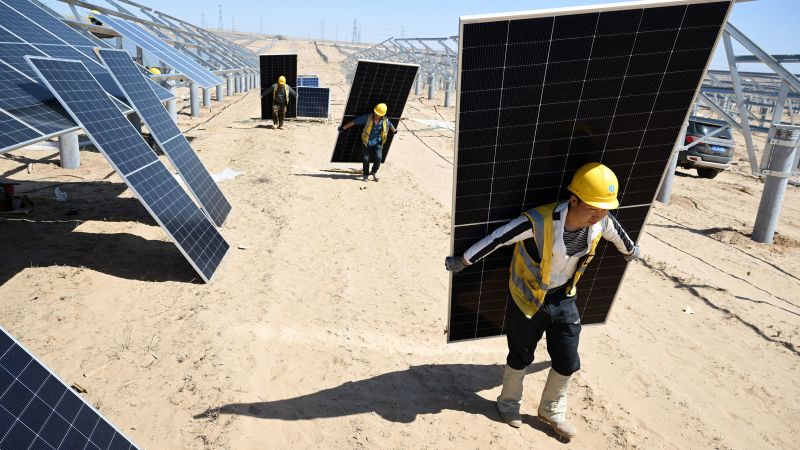
The Green Energy Landscape: China’s Meteoric Rise
The world is undergoing an unprecedented transformation in how we generate energy, and at the forefront of this revolution is China. The sheer scale of China’s commitment to renewable energy is staggering, a testament to its strategic vision and determination. In a single year, China has installed more wind and solar power capacity than the total operational renewable energy capacity currently in the United States. This remarkable achievement highlights the growing gap between the two nations in the race to dominate the clean energy sector. The data from Global Energy Monitor paints a clear picture: America is lagging behind, and the policies of the past are not helping.
What is happening in China? It’s a story of ambition, investment, and rapid deployment. The country is currently building 510 gigawatts of utility-scale solar and wind capacity, which is in addition to the existing 1,400 gigawatts already online. This means China has five times more renewable energy capacity operating than the United States. The speed at which China is expanding its renewable energy infrastructure is truly remarkable, driven by factors like government subsidies, technological advancements, and a commitment to reducing its carbon footprint. This is a clear signal of China’s commitment to a greener future and its strategic advantage in the global energy market.
America’s Missed Opportunities
The United States, on the other hand, is at a critical crossroads. The policies of the past and the current administration’s stance on renewable energy raise serious concerns about the country’s ability to compete in this rapidly evolving sector. The policies enacted by President Donald Trump have, in effect, stalled the progress of clean energy projects. The move to cut tax credits for wind and solar development will slow down the addition of renewable energy to the grid and raise electricity prices for businesses and consumers. The consequences of these decisions are far-reaching, affecting the nation’s economy and its ability to meet its climate goals.
The U.S. had approximately 275 gigawatts of wind and solar power operational by the end of last year. There are plans to build another 150 gigawatts of wind and solar by 2031, according to the U.S. Energy Information Administration. However, these projects are at risk because of the phasing out of subsidies for renewables. These policy decisions will have a negative effect on the nation’s economy and its ability to meet its climate goals. It will undermine one of Trump’s own priorities. With less wind and solar coming online and longer waiting times to get new natural gas plants running, some data centers and large manufacturing facilities may struggle to get enough power.
The Electric Vehicle Revolution
China’s transition to clean energy goes beyond power generation. The electric vehicle (EV) market in China is booming, with EVs becoming increasingly popular in urban areas. In Beijing, for example, it is rare to see a gas-powered car on the roads. This transition is driven by economic factors, with EV drivers reporting that the cost of fueling an EV is significantly lower than that of a gasoline-powered vehicle. The widespread adoption of EVs is a strong indicator of China’s commitment to reducing its reliance on fossil fuels and transitioning to a more sustainable transportation system.
The rapid adoption of EVs in China is an important factor in the country’s overall energy transition. The demand for oil has reached its peak, and there is a significant shift toward electric vehicles. China’s focus on renewable energy, combined with the growing popularity of EVs, points to a fundamental shift in the country’s energy landscape. This is a strategic move that will give China an advantage in the global energy market.
The Challenges Ahead
China’s journey to clean energy is not without its challenges. One of the most important questions is whether the country’s growing wind and solar capacity will be able to displace coal-fired power. China has a strong interest in supporting coal, but the amount of renewable energy is growing, and the energy generated from fossil fuels is decreasing. The progress China has made in increasing its renewable energy generation is a good sign. It is important to watch the progress China makes in moving to clean energy.
In the United States, the focus is on lowering energy prices. Increased energy prices will significantly hamper economic development and discourage businesses from investing in the country. With less wind and solar and long wait times to get new natural gas plants up and running, some data centers and large manufacturing facilities may struggle to get enough power. The consequences of these decisions are far-reaching, impacting the nation’s economy and its ability to meet its climate goals.
The Future of Green Energy: A Tale of Two Nations
The global energy landscape is undergoing a profound transformation, and China and the United States are at the forefront of this shift, albeit in different ways. China’s unwavering commitment to renewable energy has propelled it to the forefront of the clean energy revolution, while the United States faces a complex set of challenges and opportunities. The choices these nations make today will shape the future of the planet and determine their economic competitiveness for decades to come. The race for green energy dominance is on, and the stakes could not be higher.